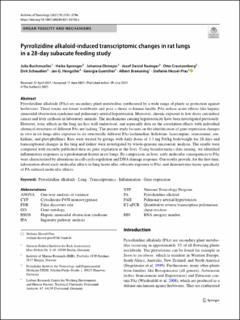| dc.description.abstract | Pyrrolizidine alkaloids (PAs) are secondary plant metabolites synthesized by a wide range of plants as protection against herbivores. These toxins are found worldwide and pose a threat to human health. PAs induce acute effects like hepatic sinusoidal obstruction syndrome and pulmonary arterial hypertension. Moreover, chronic exposure to low doses can induce cancer and liver cirrhosis in laboratory animals. The mechanisms causing hepatotoxicity have been investigated previously. However, toxic effects in the lung are less well understood, and especially data on the correlation effects with individual chemical structures of different PAs are lacking. The present study focuses on the identification of gene expression changes in vivo in rat lungs after exposure to six structurally different PAs (echimidine, heliotrine, lasiocarpine, senecionine, senkirkine, and platyphylline). Rats were treated by gavage with daily doses of 3.3 mg PA/kg bodyweight for 28 days and transcriptional changes in the lung and kidney were investigated by whole-genome microarray analysis. The results were compared with recently published data on gene regulation in the liver. Using bioinformatics data mining, we identified inflammatory responses as a predominant feature in rat lungs. By comparison, in liver, early molecular consequences to PAs were characterized by alterations in cell-cycle regulation and DNA damage response. Our results provide, for the first time, information about early molecular effects in lung tissue after subacute exposure to PAs, and demonstrates tissue-specificity of PA-induced molecular effects. | en_US |
